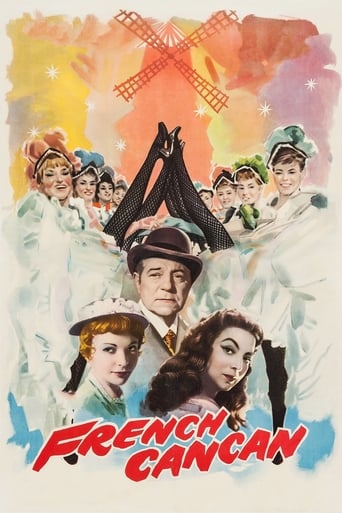cricket crockett
. . . and the period in which she morphed into a TV series followed by her hit movie, FRENCH CANCAN served as one of Western Civilization's top testaments to Girl Power. Her face may not launch a thousand ships, but "Nini" inspires the princes around her to shoot themselves, with the commoners merely reduced to a perpetual state of flying fisticuffs. Since France is a notoriously repressed and timid culture when it comes to cinema, FRENCH CANCAN falls short of the sort of "10" rating earned by "Bob Altman's" READY TO WEAR flick, because it pulls its punches for the Grand Finale. Whereas Altman's triumph about the Fashion Industry concludes with the ultimate style statement (the famous runway parade of Beauties sporting their Birthday Suits), FRENCH CANCAN falls short of its titular promise by filming scores of gymnastic splits but not one of the anatomical sort which put the Real Life "Moulin Rouge" night club on the map. Alas, Altman enjoyed the American aura of Freedom for Female Forms, whereas the director of FRENCH CANCAN is obviously hamstrung by Prudish Parisian Pudendum Pruners.
MartinHafer
This was a pleasant musical about the creation of the Moulin Rouge dance hall. In many ways, this reminds me of the Hollywood musicals of the 40s and 50s, in that it has many clichés leading up to the inevitable conclusion ("will the show STILL go on?"). While of course none of this is new, it was enjoyable and well made. The musical numbers at the end are frenetic and beautiful to watch. In many ways it reminds me of a sexier version of THE GREAT ZIEGFELD. In real life, Ziegfeld was quite the player but this was sanitized in the American film. But, in FRENCH CANCAN, the characters have fully functioning libidos--but nothing is really shown, so the movie is okay for kids.Nothing new but well done nevertheless.
Terrell-4
The story is simple but the execution is marvelous. A Belle Epoque impresario, down on his financial luck, is going to open a new club, the Moulin Rouge, with a new dance, the French cancan. He encounters a working girl and makes her a dancer. She'll become a star. There are several crises to overcome before that happens.The movie is Jean Renoir's tribute to show business, and he puts it on the screen with color, verve, humor, and humanity. There are wonderful performances by all the actors. The leads are Jean Gabin as Henri Danglard, the impresario; Francoise Arnoul as Nini, the girl who'll become a star; and Maria Felix as Lola de Castro, an overwhelmingly tempestuous beauty and Danglard's lover at the start. Gabin exudes confidence, worldly humor and dedication to show business. He even dances a bit. Arnoul is first rate, too. It looks like she was doing her own dances, and as an actress think of a young Leslie Caron with brains and charm.The climax of the movie is the opening of the club, with Felix's star dance, comic songs, a whistler, a Danglar-discovered singer, all moving toward the introduction of the French cancan. The crises happen and are resolved. Then the cancan explodes. Dancing girls come bursting out from the stage, the front of the theater, through posters, down ropes from the balcony. The house swirls with the black tie and tails of the swells and the garish colors of the dancers' gowns. The cancan number lasts probably ten or fifteen minutes or so, all music and gaiety, all high kicks and splits. It's amazing when row after row of the dancers, moving toward the camera through the audience, leap up, legs extended straight forward and backward, backs arched, then land on the dance floor in full splits. I didn't know whether to shout or wince.The last scene of the movie is outside the club, shot from the cobblestone street looking at the entrance. It's a medium shot and from the side street a happy, inebriated fellow in black tie and top hat staggers across, pauses to tip his hat at the camera, then staggers off. A completely charming ending.This really is a marvelous movie.
writers_reign
Acknowledgments to Cole Porter from whose lyric CanCan (the title song of his 1953 Broadway show of the same name) I take my one line summary. This is, purely and simply, a Valentine to Paris, the Belle Epoque, the Impressionists, you-name-it. As such it is both stunning and sumptuous.Gabin - who began in the French Music Halls - is superb, but then when isn't he, Arnoul is a revelation. More? Well, the photography is ... the music is ... the ambience is ... aw, what the hell, go see it, do yourself a great big favor. 9/10



